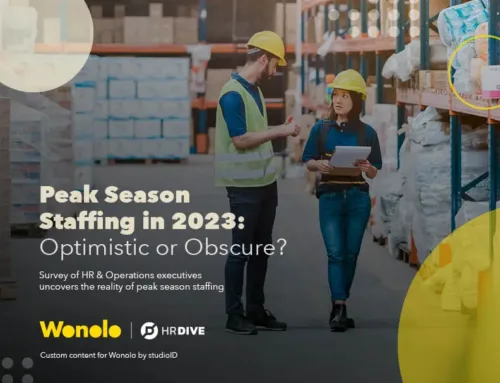Wonolo
The gig economy is growing year after year.
Now is the best time in history to hire freelance workers to help you with projects both large and small.
With hiring platforms, it’s easier than ever to get help within days or even hours. But to make it worthwhile, you need to know exactly how to hire temporary workers.
Working at home, doing something online without ever having to get dressed or leave the house, sounds appealing. You can choose when you want to work, and you won’t have anyone looking over your shoulder. It’s the perfect job, right?
Well, it is the perfect job for someone who commits to it, schedules his/her time, follows directions, communicates well and follows through on assignments and projects, and completes them on time and accurately.
Unfortunately, that isn’t the only type of person you’ll find when looking to hire someone online. The low barrier to entry in online applications oftentimes means you’ll get a larger selection of poorly qualified candidates.
Since eight out of ten respondents think that it’s challenging to find high-quality applicants in traditional means, it only becomes more difficult online.

In this guide, you’ll learn exactly how to find quality candidates who will get the job done right, every time.
Let’s dive in!
Communicate Effectively (And Show You Care)
So what is the secret to hiring online workers who will actually get the job done?
There is no simple answer, but the following practices will increase the likelihood that you find hires who are a great fit, and stick around for the long term.
First, communicate. If you want the hire to work for you, workers need to know who you are, what company you represent, and what business or industry the company is part of. These help build a sense of loyalty and purpose behind the work.
He or she also needs to understand what you require. Be clear on your expectations of what you want him or her to do, and how much you’re going to pay them. Don’t be coy or play games. You could lose the potential worker.

An online job description with a stated pay range is enough to keep a prospect interested. It lets him or her know that it’s a real job and that you’re not just trying to trick someone into giving you their money or identity.
Despite your best efforts, though, you’ll always run into some skepticism when using the internet to find workers. Using a worker platform like Wonolo will add a layer of authority and credibility, making it much easier to find qualified workers who trust you.
An online application is also a good idea. This gives you the basic information you need about the potential worker. Make sure it’s short–research shows an application should take around five minutes to complete.

Once the application has been submitted, follow up with a short email from you or from another human being, thanking the applicant for submitting.
This makes all the difference. No matter how automated the world gets and how much farther apart we seem to grow, everyone wants to be recognized and treated like a person.
Hearing from you soon after a worker has completed the application tells him or her that you’re serious, as well as indicating that you’re willing to personalize the experience.
Some people believe you should follow-up with live communication, like a phone call or video chat, but this really isn’t the case.
True, there was a time when workers would have preferred getting a phone call rather than an email. But an email carries a few advantages that today’s gig economy workers find enticing.
First, you can include large amounts of information in an email and you don’t have to worry about the worker forgetting everything you said. If workers have it all right there in their inbox, they can look at it as many times as they need to.
Another reason to prefer email is because people are more comfortable communicating through the medium. You’re more likely to get an immediate response through email than scheduling a time you’re both available to talk in real time.
Set Clear Expectations from the Beginning
It’s a common mistake.
You start off working with your new hire, and things are going well. But gradually, the quality of his or her work begins to slip, and you’re not sure where you went wrong.
The answer lies in setting expectations clearly from the beginning.
Tell the worker in a clear and simple way–explaining every single detail and step in the process–exactly what will be expected of them on a daily and weekly basis. Don’t assume that workers already know the details.
Every business has a slightly different process, and explaining the key differentiators of how you do business is critical to a successful hire.
Since a manager will spend more than one-half of his or her workweek on hiring-related tasks, setting expectations is a valuable investment of your time.

The tricky part about this is to carefully and thoroughly explain without talking down to the new hire. A good technique to use is framing your expectations as something you’re sure he or she already knows, but you want to clarify.
It will also help to explain how his or her contribution will help your customers and the company. We all want to be part of something larger than ourselves, and that includes your new hires.
Make sure workers have all of the information they need, such as websites, login information, and access codes–to get started. Work to establish a schedule that workers can adhere to, and hold the new hire to it.
Give him or her a trial project with a reasonable deadline. Ensure that all necessary tools are readily available, and that workers know how to reach you, or a designated trainer, if they have any questions.
Outline what you want done and when it is to be be completed. Include exactly how the finished project should be submitted.
Gig economy workers value freedom above most other areas, so don’t hover and micromanage. But that doesn’t mean you should leave the new hire without accountability.
Follow up Frequently and Provide Guidance
It’s a good idea to check with your workers about halfway through to the designated completion date. This will give you a chance to ask some questions about how things are going, and to answer any questions the workers may have.
It will also give you a clear idea of how each person works. You can find out which new hires are procrastinators, which are go-getters, and which are in between. Depending on their style, you may need to adjust your management.
Give staff a clear reminder of the deadline you have set and make sure workers commit to meeting it. Don’t accept any excuses or stories. Set the expectation now that the work has to be done on time. It will save you a lot of trouble later.
While it may seem tough to set these expectations so early on, it’s a good investment of your time. Being firm with new hires will save you headache down the road, and keep you from needing to hire a new employee.
Finally, provide helpful feedback. It isn’t enough to check up–you need to clarify and build the worker’s understanding of the project.
Your hires need to know why something they do is good or bad, right or wrong. It’s not enough to tell them they messed up or that he or she “did fine”. What does that even mean?
When you present your evaluation of work, be specific about what you like, what you don’t like, and why. Explain how meeting the standards affects the customer and the company.
Then, give the worker the opportunity to evaluate the job, the company, and you. Is it something he or she would like to continue to do? What did he or she like and dislike about it?
Provide concrete feedback, preferably in a written form that your worker can access later.
The keys to hiring and keeping online workers who will get the job done are to consistently communicate, set expectations, follow up and evaluate.
Work to establish accountability, and treat your new hire as a member of the team. You’ll build a team of workers eager to put in the work to get the job done.


![[Report] Beyond the Gig: Exploring Reliable Work Options for the Modern Workforce](https://info.wonolo.com/wp-content/uploads/2023/10/Worker-Preferences-Report-Header-Image-500x383.png)



